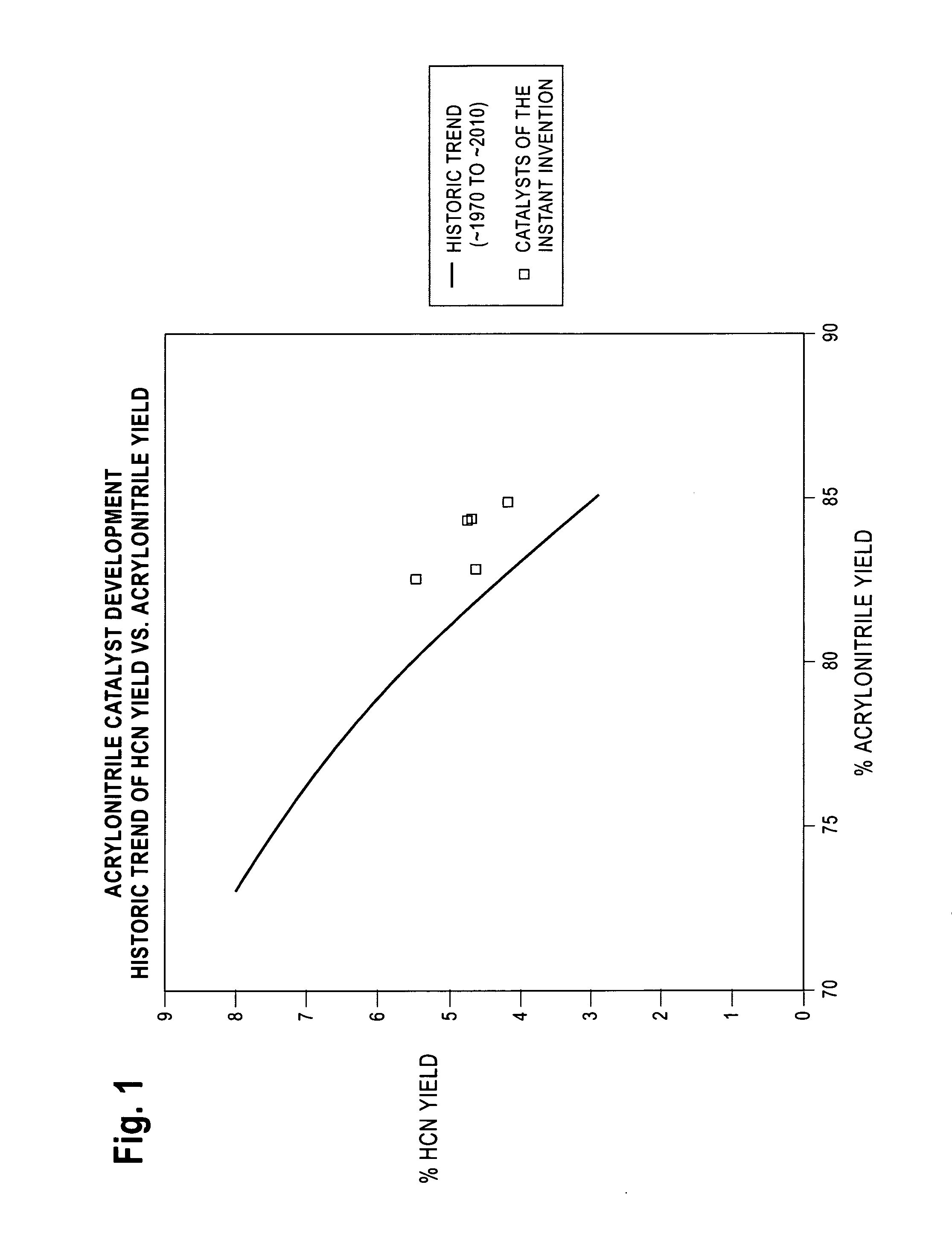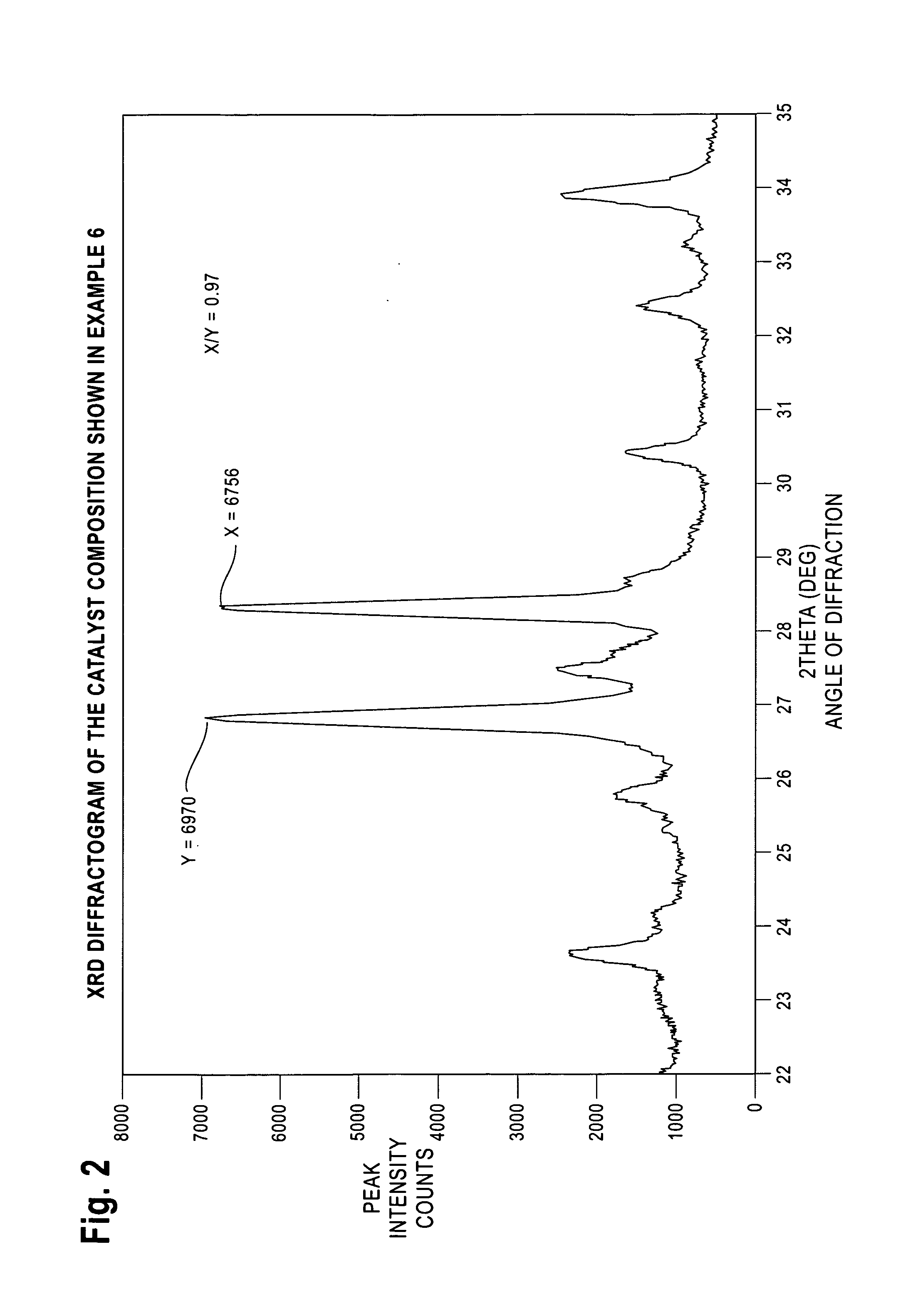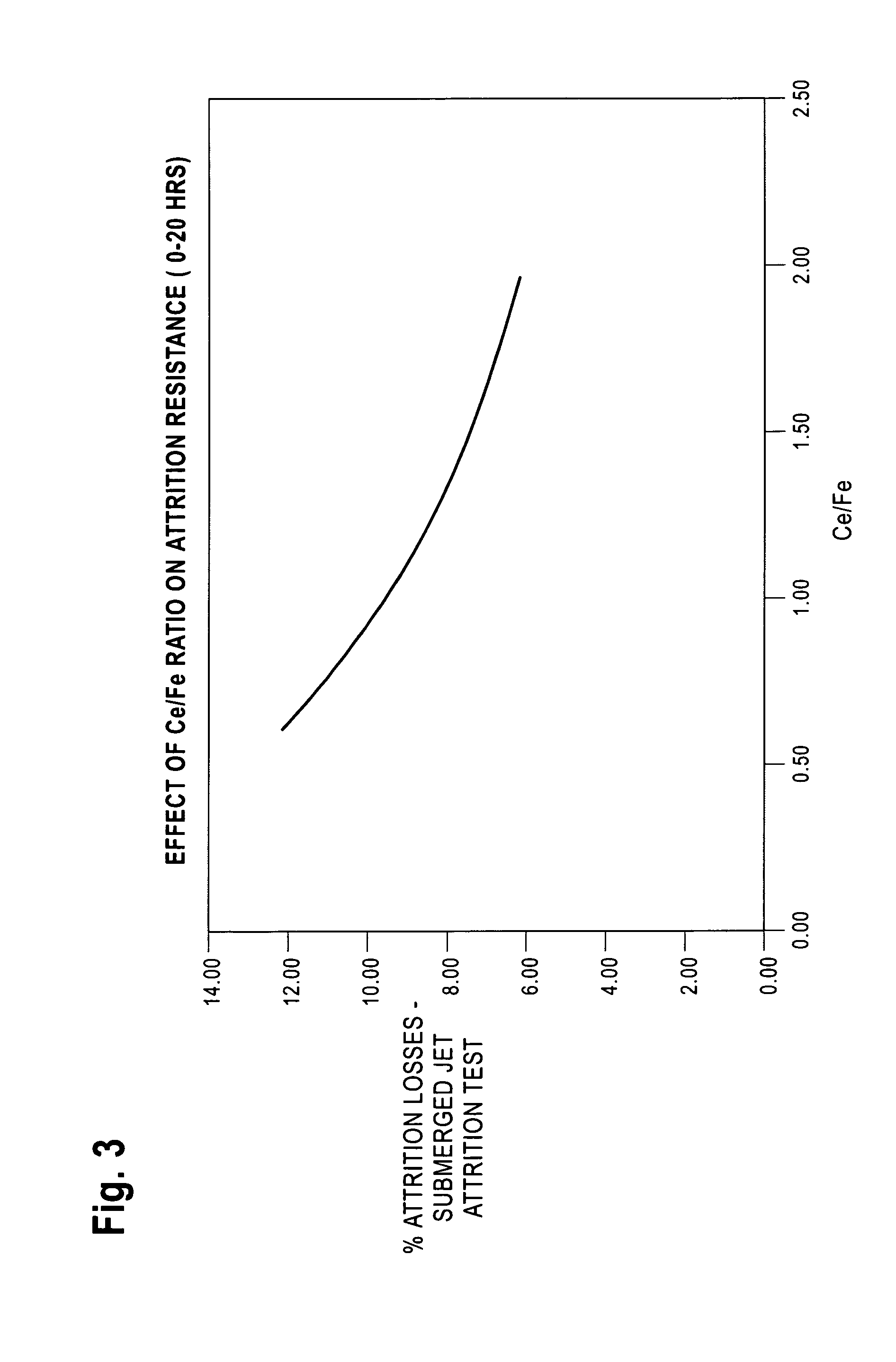High efficiency ammoxidation process and mixed metal oxide catalysts
a catalyst and ammoxidation process technology, applied in physical/chemical process catalysts, bulk chemical production, other chemical processes, etc., can solve the problems of multiple step preparation and more complex preparation, and achieve the effects of reducing the yield of hydrogen cyanide and/or acetonitrile coproducts, reducing the yield of acrylonitrile, and reducing the overall conversion rate of propylen
- Summary
- Abstract
- Description
- Claims
- Application Information
AI Technical Summary
Benefits of technology
Problems solved by technology
Method used
Image
Examples
specific embodiments
[0109]In order to illustrate the instant invention, catalyst prepared in accordance with the instant invention were evaluated and compared under similar reaction conditions to similar catalysts prepared by prior art methods outside the scope of the instant invention. These examples are provided for illustrative purposes only.
[0110]Catalysts having the composition of Cs0.1K0.1Ni5Mg2Na0.05Fe1.8Bi0.45Ce1.1Mo12.55O50.35+45 wt % Na SiO2 were prepared by various preparation methods as described below and tested in a bench scale reactor for the ammoxidation of propylene to acrylonitrile. All testing was conducted in a 40 cc fluid bed reactor. Propylene was feed into the reactor at a rate of 0.06 WWH (i.e. weight of propylene / weight of catalyst / hour). Pressure inside the reactor was maintained at 10 psig. The propylene / ammonia / air molar ratio was approximately 1 / 1.2 / 9.5. Reaction temperature was 430° C. After a stabilization period of ˜20 hours or more, samples of reaction products were col...
example 1
Prepared in Accordance with the Invention
[0122]Reaction mixture A was prepared by heating 198 ml of deionized water to 65° C. and then adding with stirring over 30 minutes ammonium heptamolybdate (180.4 g) to form a clear colorless solution. Silica sol (692 g, 32.5 wt % silica) was then added with stirring.
[0123]Reaction mixture B was prepared by heating 33 ml of deionized water to 55° C. and then adding with stirring Fe(NO3)3.9H2O (73.6 g), Ni(NO3)2.6H20 (147.1 g), and Mg(NO3)2.6H2O (51.9 g).
[0124]Reaction mixture C was prepared by heating 48 ml of deionized water to 65° C. and then adding with stirring over 30 minutes ammonium heptamolybdate (43.75 g) to form a clear colorless solution.
[0125]Reaction mixture D was prepared by (i) heating 122.0 g of 50 wt % aqueous (NH4)2Ce(NO3)6 solution to 55° C., and (ii) while the solution was stirring and heating, sequentially adding Bi(NO3)3.5H2O (22.1 g), CsNO3 (1.97 g), KNO3 (1.02 g), and NaNO3 (0.43 g), resulting in a clear orange solution...
example 2
Prepared in Accordance with the Invention
[0130]Reaction mixture A was prepared by heating 198 ml of deionized water to 65° C. and then adding with stirring over 30 minutes ammonium heptamolybdate (180.4 g) to form a clear colorless solution.
[0131]Reaction mixture B was prepared by heating 33 ml of deionized water to 55° C. and then adding with stirring Fe(NO3)3.9H2O (73.6 g), Ni(NO3)2.6H2O (147.1 g), and Mg(NO3)2.6H2O (51.9 g).
[0132]Reaction mixture C was prepared by heating 48 ml of deionized water to 65° C. and then adding with stirring over 30 minutes ammonium heptamolybdate (43.75 g) to form a clear colorless solution.
[0133]Reaction mixture D was prepared by (i) heating 122.0 g of 50 wt % aqueous (NH4)2Ce(NO3)6 solution to 55° C., (ii) while the solution was stirring and heating, sequentially adding Bi(NO3)3.5H2O (22.1 g), CsNO3 (1.97 g), KNO3 (1.02 g), and NaNO3 (0.43 g), resulting in a clear orange solution.
[0134]Reaction mixture E was prepared by adding with stirring reaction...
PUM
| Property | Measurement | Unit |
|---|---|---|
| 2θ angle | aaaaa | aaaaa |
| weight percent | aaaaa | aaaaa |
| weight percent | aaaaa | aaaaa |
Abstract
Description
Claims
Application Information
 Login to View More
Login to View More - R&D
- Intellectual Property
- Life Sciences
- Materials
- Tech Scout
- Unparalleled Data Quality
- Higher Quality Content
- 60% Fewer Hallucinations
Browse by: Latest US Patents, China's latest patents, Technical Efficacy Thesaurus, Application Domain, Technology Topic, Popular Technical Reports.
© 2025 PatSnap. All rights reserved.Legal|Privacy policy|Modern Slavery Act Transparency Statement|Sitemap|About US| Contact US: help@patsnap.com



